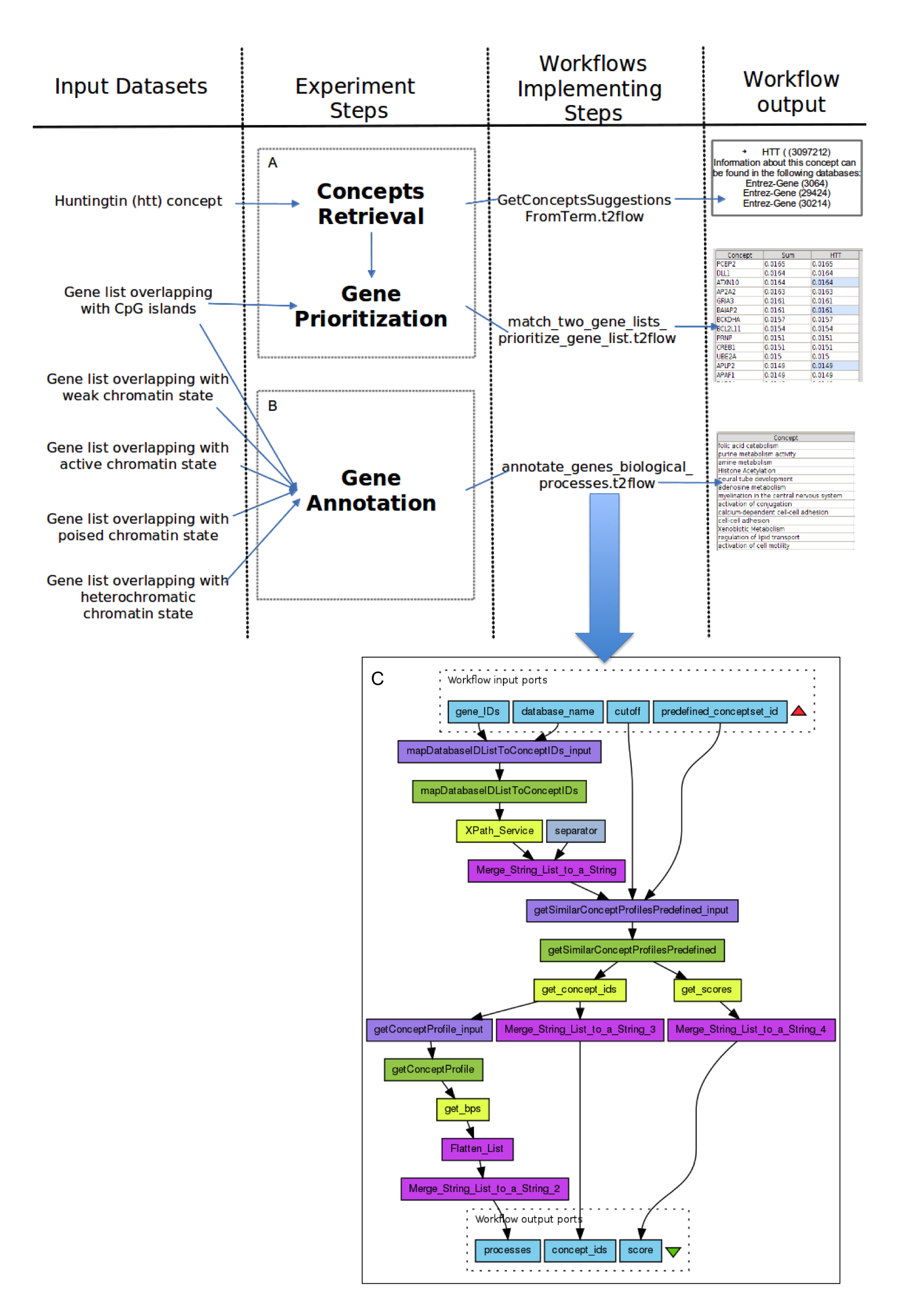676 Matching Annotations
- May 2022
-
www.eidr.org www.eidr.org
-
www.w3.org www.w3.org
-
www.w3.org www.w3.org
Tags
Annotators
URL
-
-
webhooks.pbworks.com webhooks.pbworks.com
-
www.w3.org www.w3.orgWebSub1
Tags
Annotators
URL
-
-
-
ror.readme.io ror.readme.ioROR1
Tags
Annotators
URL
-
-
vocab.linkeddata.es vocab.linkeddata.es
-
The paper describes four ontologies for representing workflows in Research Objects, and includes examples and motivation scenarios.
The ontologies developed make use of and extend existing well known ontologies, namely the Object Reuse and Exchange (ORE) vocabulary, the Annotation Ontology (AO) and the W3C PROV ontology (PROVO). We illustrate how the ontologies can be utilized using a real-world scenario, in which scientists created a Workflow Research Object for an investigation on the Huntington's disease. We also present the tools we developed for managing Workflow Research Objects.

-
-
www.myexperiment.org www.myexperiment.org
-
www.openarchives.org www.openarchives.org
Tags
Annotators
URL
-
-
www.openarchives.org www.openarchives.org
Tags
Annotators
URL
-
-
raft.github.io raft.github.io
Tags
Annotators
URL
-
- Apr 2022
-
www.geocaching.com www.geocaching.com
Tags
Annotators
URL
-
-
wicg.github.io wicg.github.io
-
Tags
Annotators
URL
-
-
www.xml.com www.xml.com
Tags
Annotators
URL
-
-
web.dev web.dev
Tags
Annotators
URL
-
-
ldapwiki.com ldapwiki.com
-
www.bortzmeyer.org www.bortzmeyer.org
- Mar 2022
-
www.vinzius.com www.vinzius.com
-
vpic.nhtsa.dot.gov vpic.nhtsa.dot.gov
-
radiodns.org radiodns.org
Tags
Annotators
URL
-
-
www.dmrfordummies.com www.dmrfordummies.com
-
What Is A DMR Radio ID? A Radio ID is a unique number assigned to you (and your callsign) by the RadioID.net Team. Like a telephone number or IP address, your Radio ID identifies you as a unique radio user on the various DMR networks and repeaters around the world.
-
-
justinmeiners.github.io justinmeiners.github.io
-
www.ismn-international.org www.ismn-international.org
Tags
Annotators
URL
-
-
wordnet-rdf.princeton.edu wordnet-rdf.princeton.edu
Tags
Annotators
URL
-
-
oclc-research.github.io oclc-research.github.io
-
eur-lex.europa.eu eur-lex.europa.eu
-
support.isan.org support.isan.org
-
maastrichtu-ids.github.io maastrichtu-ids.github.io
Tags
Annotators
URL
-
-
www.infoq.com www.infoq.com
-
howdnssec.works howdnssec.works
Tags
Annotators
URL
-
-
www.w3.org www.w3.org
Tags
Annotators
URL
-
-
road.issn.org road.issn.org
-
www.w3.org www.w3.org
-
www.w3.org www.w3.org
-
Position Statement W3C Video Workshop 12/13th Dec 2007
"Architecture of a Video Web - Experience with Annodex"
- Dr Silvia Pfeiffer
- Vquence, Xiph.org and Annodex.org
-
-
ivoa.net ivoa.net
-
help.apple.com help.apple.com
Tags
Annotators
URL
-
-
mgnet.me mgnet.me
Tags
Annotators
URL
-
-
www.law.cornell.edu www.law.cornell.eduURN:lex1
-
profilenegotiation.github.io profilenegotiation.github.io
-
Abstract This document defines two new HTTP headers "Content-Profile" and "Accept-Profile" that enable User Agents and hosts to indicate and negotiate the profile used for representing a specific resource. In this context, a profile is a description of the structural and/or semantic constraints of a group of documents in addition to the syntactical interpretation provided by more generic MIME types. Examples of profiles include Dublin Core Application Profiles, XML Schemata, and RDF Shape Expressions. This document further defines and registers the "profile" parameter for the HTTP "Link" header and suggests a best practice for the use of the new headers together with the "Link" header for the purposes of performing content negotiation and pointing clients to alternate representations.
-
-
mementoweb.org mementoweb.org
-
maggieappleton.com maggieappleton.com
-
www.w3.org www.w3.org
Tags
Annotators
URL
-
-
www.doi.org www.doi.org
-
inkscape.org inkscape.org
Tags
Annotators
URL
-
-
webglfundamentals.org webglfundamentals.org
Tags
Annotators
URL
-
-
wiki.archiveteam.org wiki.archiveteam.org
-
To download a file and save the request and response data to a WARC file, run this:
bash wget "http://www.archiveteam.org/" --warc-file="at"
-
-
info.orcid.org info.orcid.org
-
www.w3.org www.w3.org
Tags
Annotators
URL
-
-
citationstyles.org citationstyles.org
Tags
Annotators
URL
-
-
meenalpathak.wordpress.com meenalpathak.wordpress.com
-
Pierre Bézier (Renault), a French engineer and one of the founders in the field of solid, geometric and physical modelling and Paul De Casteljau (Citroën), a French Mathematician and physicist developed an algorithm to calculate a family of curves. These curves are named as Bézier curves while the algorithm is named after De Casteljau, DeCasteljau’s algorithm. The algorithm and the Bézier curves are used in almost all the graphic tools. Before the invention of these tools, the software could not understand a shape if it wasn’t a circle, a parabola or a basic line. The availability of hardware that could machine complex 3-D shapes and lack of the software that could not communicate the specifics of those shapes created a gap. The Bézier curves solved this issue. They were used in creating the design of body parts of Renault and Peugeot cars as early as in 1960s.
-
-
web.dev web.dev
Tags
Annotators
URL
-
-
id3.org id3.org
Tags
Annotators
URL
-
-
martin-thoma.com martin-thoma.com
-
www.w3.org www.w3.org
Tags
Annotators
URL
-
-
arks.org arks.org
-
Archival Resource Keys (ARKs) serve as persistent identifiers, or stable, trusted references for information objects. Among other things, they aim to be web addresses (URLs) that don’t return 404 Page Not Found errors.
-
-
www.xspf.org www.xspf.org
Tags
Annotators
URL
-
-
musicbrainz.org musicbrainz.org
Tags
Annotators
URL
-